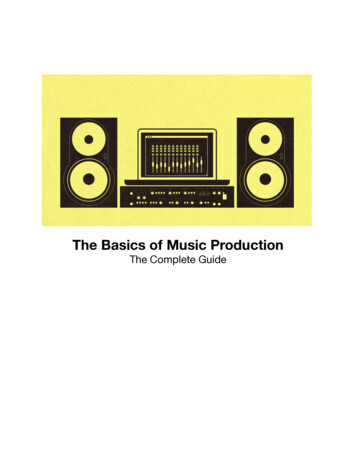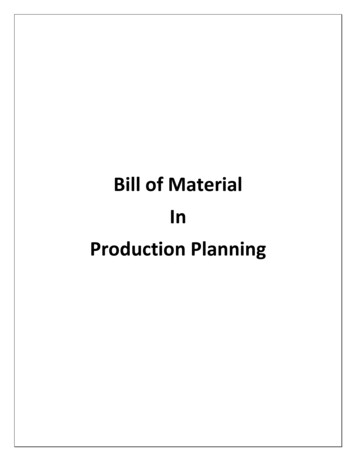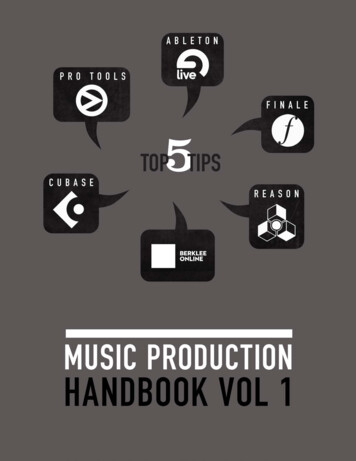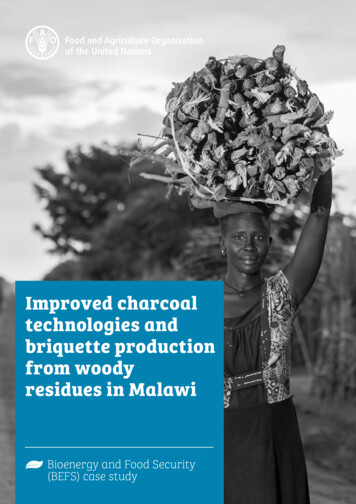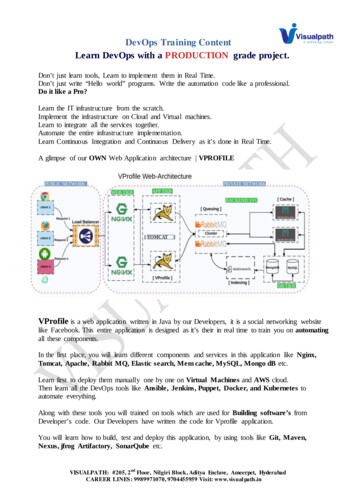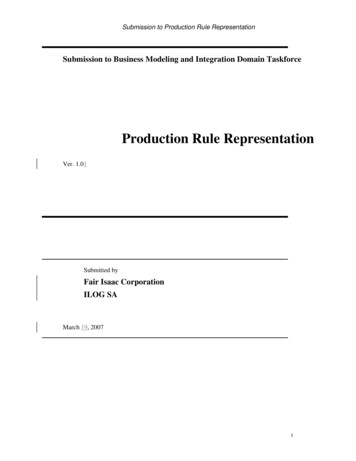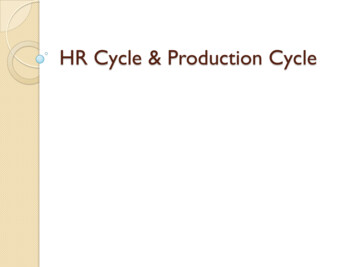
Transcription
HR Cycle & Production Cycle
Topik BahasanHuman Resource Cycle Production Cycle
Sumber Materi Romney / Steinbart, AccountingInformationSystems, 9th Edition ch.11-12, PrenticeHall
The Human ResourcesManagement/Payroll CycleChapter 14
Learning ObjectivesDescribe the major business activities and relateddata processing operations performed in thehuman resources management (HRM)/payrollcycle.2. Identify the major threats in the HRM/payrollcycle, and evaluate the adequacy of variousinternal control procedures for dealing withthem.1.
Learning Objectives3.4.5.Explain the key decisions that need to bemade in the HRM/payroll cycle, and identifythe information required to make thosedecisions.Read and understand a data model (REAdiagram) of the HRM/payroll cycle.Create a data model (REA diagram) of theHRM/payroll cycle.
Introduction The HRM/payroll cycle is a recurring setof business activities and related dataprocessing operations associated witheffectively managing the employee workforce.Some of the more important activitiesinclude the following tasks:– recruitment and hiring– training
Introduction– job assignment– compensation (payroll)– performance evaluation– discharge of employees, due to voluntary orinvoluntary termination This chapter focuses primarily on thepayroll system.
Learning Objective 1Describe the major businessactivities and related dataprocessing operations performedin the human resourcesmanagement (HRM)/payrollcycle.
Payroll Cycle ActivitiesThe first function of the AIS isprocessing transactional data. Why is payroll processed in batchmode? Paychecks are prepared periodically. Most employees are paid at the same time.
Payroll Cycle Activities What are the basic activities performed in thepayroll cycle?1.2.3.4.5.6.7.Update master payroll fileUpdate tax rates and deductionsValidate time and attendance dataPrepare payrollDisburse payrollCalculate employer-paid benefits and taxesDeduct payroll taxes and other deductions
Update Master Payroll File(Activity 1)The first activity in the HRM/payroll cycleinvolves updating the payroll master file toreflect payroll changes such as new hires,terminations, changes in pay rates, or changes indiscretionary withholdings. It is important that all payroll changes areentered in a timely manner and are properlyreflected in the next pay period.
Update Tax Rates andDeductions (Activity 2) The second activity in the HRM/payrollcycle involves updating information abouttax rates and other withholdings.These changes happen whenever updatesabout changes in tax rates and otherpayroll deductions are received fromvarious government units and insurancecompanies.
Validate Time andAttendance Data (Activity 3)The third activity in the payroll cycle istovalidate each employee’s time and attendancedata. This information comes in various forms,depending on an employee’s status. What are some pay schemes? – time cards for those paid on an hourly basis– self report for professionals
Validate Time andAttendance Data (Activity 3)– straight commission or salary pluscommission– incentives and bonusesProcedures: The payroll department is responsiblefor validating employee time records. For factory workers, validation involvescomparing the total time worked withthe time spent on each job.
Validate Time andAttendance Data (Activity 3)The payroll clerk calculates batch totals andenters them along with the time data. The batch totals are recalculated by the computerafter subsequent processing steps. Payroll transaction data are entered throughonline terminals. Edit checks are performed on each time andattendance record.
Opportunities for UsingInformation Technology What are some opportunities of usinginformation technology to validate timeand attendance data (Activity 3)?– collecting employee time and attendance dataelectronically, instead of on paper documents– using badge readers– using electronic time clocks
Prepare Payroll (Activity 4)The fourth activity in the payroll cycle involvespreparing payroll. Data about the hours worked are provided bythe department in which the employee works. Pay rate information is obtained from thepayroll master file. The person responsible for preparing paycheckscannot add new records to this file.
Prepare Payroll (Activity 4)Procedures: Payroll processing is performed in thecomputer operations department. The payroll transaction file is sorted byemployee number. The sorted time data file is used toprepare employee paychecks.
Prepare Payroll (Activity 4)All payroll deductions are summed andthe total is subtracted from gross pay toobtain net pay. What are types of payroll deductions? – withholdings– voluntary deductions Finally, the payroll register and employeepaychecks are printed.
Opportunities for UsingInformation Technology What are some opportunities of usinginformation technology to prepare payroll(Activity 4)?– produce and distribute payroll reportselectronically rather than on paper– online terminals– corporate intranets
Disburse Payroll (Activity 5)The fifth activity is actual disbursement ofpaychecks to employees. Most employees are paid either by checkor by direct deposit of the net pay amountinto the employee’s bank account.
Disburse Payroll (Activity 5)Procedures: Once paychecks have been prepared, the payrollregister is sent to the accounts payabledepartment for review and approval. A disbursement voucher is then prepared. The disbursement voucher and payroll registerare then sent to the cashier.
Opportunities for UsingInformation Technology What are some opportunities of usinginformation technology to disburse payroll(Activity 5)?– direct deposit– outsourcing to a payroll service bureau
Calculate Employer-Paid Benefitsand Taxes (Activity 6)Some payroll taxes and employee benefits arepaid directly by the employer. Federal and state laws require employers tocontribute a specified percentage of eachemployee’s gross pay to federal and stateunemployment compensation insurance funds. Employers often contribute to health, disability,and insurance premiums.
Calculate Employer-Paid Benefitsand Taxes (Activity 6)Many companies also offer their employeesflexible benefit plans. Many employees are offered and contributetoward a choice of retirement savings plans.
Disburse Payroll Taxes andOther Deductions (Activity 7)The final activity in the payroll processinvolves paying the payroll tax liability andthe other voluntary deductions of eachemployee. An organization must periodically preparechecks or use electronic transfer to paythe various tax liabilities incurred.
Disburse Payroll Taxes andOther Deductions (Activity 7)The timing of these payments is specifiedby the respective government agencies. The funds voluntarily withheld from eachemployee’s paycheck for various benefitsmust be disbursed to the appropriateorganizations.
Learning Objective 2Identify the major threats in theHRM/payroll cycle,andevaluate the adequacy ofvarious internal controlprocedures for dealingwith them.
Control Objectives,Threats, and Procedures The second function of the AIS in the HRM/payrollcycle is to provide adequate internal controls toensure meeting the following objectives:1.2.3.4.payroll transactions are properly authorizedrecorded payroll transactions are validauthorized payroll transactions are recordedpayroll transactions are accurately recorded
Control Objectives,Threats, and Procedures5.6.7.applicable government regulationsregarding remittance of taxes and filing ofpayroll and HRM reports are metassets (both cash and data) aresafeguarded from loss or theftHRM/payroll cycle activities areperformed efficiently and effectively
Control Objectives,Threats, and Procedures What are some threats?1. hiring of unqualified or larcenous employees2. violation of employment law3. unauthorized changes to the master payrollfile4. inaccurate time data5. inaccurate processing of payroll6. theft or fraudulent distribution of paychecks7. loss or unauthorized disclosure of payrolldata8. poor performance
Control Objectives,Threats, and Procedures What are some exposures? increased expenseslower productivitytheftfines and civil suitsinaccurate records and reportsover/underpayment of employeesreduced morale
Control Objectives,Threats, and Procedures What are some control procedures?– sound hiring practices (verification of jobapplicant’s skills, references, and employmenthistory)– thorough documentation of hiringprocedures– segregation of duties– batch totals and other application controls
Control Objectives,Threats, and Procedures– direct deposit– paycheck distribution by someoneindependent of payroll process– investigation of all unclaimed paychecks– separate payroll checking account– access control– backup procedures– encryption
Learning Objective 3Explain the key decisions thatneed to be made in theHRM/payroll cycle, and identifythe information required tomake those decisions.
Information Needsand ProceduresThe third function of the AIS is to provideinformation useful for decision making. The payroll system must be designed tocollect and integrate cost data with othertypes of information in order to enablemanagement to make the following kindsof decisions:
Information Needsand ProceduresFuture work force staffing needs2 Employee performance3 Employee morale4 Payroll processing efficiencyand effectiveness1
Information Needsand ProceduresSome of the information has traditionally beenprovided by the payroll system. Other information, such as data about employeeskills, had normally been provided andmaintained by the HRM system. Other information, such as data about employeemorale, has traditionally not been collected.
The Production CycleChapter 13
Learning Objectives1.2.3.Describe the major business activities andrelated data processing operations performed inthe production cycle.Explain how a company’s cost accounting systemcan help it achieve its manufacturing goals.Identify major threats in the production cycle,and evaluate the adequacy of various controlprocedures for dealing with those threats.
Learning Objectives4.5.6.Discuss the key decisions that need to bemade in the production cycle, and identify theinformation needed to make those decisions.Read and understand an REA data model ofthe production cycle.Develop an REA data model for theproduction cycle.
Learning Objective 1Describe the major businessactivities and related dataprocessing operationsperformed in theproduction cycle.
Production Cycle ActivitiesThe production cycle is a recurring set ofbusiness activities and related dataprocessing operations associated with themanufacturing of products. The first function of the AIS is to supportthe effective performance of theorganization’s business activities.
Production Cycle Activities What are the four basic activities in theproduction cycle?1 Product design2 Planning and scheduling3 Production operations4 Cost accounting
Product Design (Activity 1)The first step in the production cycle isproduct design. The objective of this activity is to design aproduct that meets customerrequirements for quality, durability, andfunctionality while simultaneouslyminimizing production costs.
Product Design (Activity 1)Documents and procedures: The product design activity creates twomain documents:1 Bill of materials2 Operations list
Product Design (Activity 1) How can accountants be involved in productdesign?– by showing how various design trade-offs affectproduction costs and thereby profitability– by ensuring that the AIS is designed to collectand provide information about the machinesetup and materials handling costs associatedwith alternative product designs– by providing data about repair and warrantycosts associated with existing products
Planning and Scheduling (Activity2)The second step in the production cycleis planning and scheduling. The objective of this step is a productionplan efficient enough to meet existingorders and anticipate short-term demandwithout creating excess finished goodsinventories.
Planning and Scheduling (Activity2) What are two common methods ofproduction planning?1 Manufacturing resource planning (MRP-II)2 Just-in-time (JIT) manufacturing systems MRP-II is an extension of materials resourceplanning that seeks to match existing productioncapacity and raw materials needs with forecastedsales demands. The goal of JIT is to minimize inventories of rawmaterials, work in process, and finished goods.
Planning and Scheduling (Activity2)Documents and procedures: The master production schedule (MPS) specifieshow much of each product is to be producedduring the planning period and when thatproduction should occur. A production order authorizes manufacturing. A materials requisition authorizes removal ofmaterials from the storeroom to the factory.
Planning and Scheduling (Activity2) How can accountants be involved inplanning and scheduling?– by ensuring that the AIS collects andreports costs in a manner consistent withthe production planning techniques usedby the company– by helping to choose whether MRP-II orJIT is more appropriate
Production Operations(Activity 3) The third step in the production cycle isthe actual manufacture of products.The manner in which this activity isaccomplished varies greatly acrosscompanies.What is computer-integratedmanufacturing (CIM)? It is the use of information technology in theproduction process.
Production Operations(Activity 3) Every firm needs to collect data aboutthe following four facets of itsproduction operations:1.2.3.4.Raw materials usedLabor-hours expendedMachine operations performedOther manufacturing overhead costsincurred
Learning Objective 2Explain how a company’s costaccounting system can help itachieve its manufacturing goals
Cost Accounting (Activity 4)The final step in the production cycle iscost accounting. What are the three principal objectives ofthe cost accounting system? 1. To provide information for planning, controlling,and evaluating the performance of productionoperations2. To provide accurate cost data about productsfor use in pricing and product mix decisions3. To collect and process the information used tocalculate the inventory and cost of goods soldvalues
Cost Accounting (Activity 4) What are two types of cost accounting systems?1 Job-order costing2 Process costing Job-order costing assigns costs to specific productionbatches or to individual jobs. Process costing assigns costs to each process, andthen calculates the average cost for all unitsproduced.
Cost Accounting (Activity 4)The choice of job-order or processcosting affects only the method used toassign costs to products, not the methodused for data collection. Raw Materials: When production is initiated, the issuance of amaterials requisition triggers the journalentry.
Cost Accounting (Activity 4)Assume that 15,000 of raw materialswere issued. What is the journal entry? Work in ProcessRaw Materials Inventory15,00015,000record issuance of raw materials Assume that 1,000 of raw materialswere returned to inventory.To
Cost Accounting (Activity 4) What is the journal entry? Raw Materials InventoryWork in Process1,0001,000To record return of raw materials toinventory Most raw materials are bar-coded.Inventory clerks use online terminals toenter usage data for those items that arenot bar-coded.
Cost Accounting (Activity 4)Direct Labor: A job-time ticket is a paper document used tocollect data about labor activity. This document records the amount of time aworker spent on each specific job task. Workers can enter this data using onlineterminals at each factory workstation.
Cost Accounting (Activity 4) Workers can use code identification cardsthat run through a badge reader or barcode scanner when they start and finishany task.Manufacturing Overhead:What is manufacturing overhead?– all manufacturing costs that are noteconomically feasible to trace directly tospecific jobs or processes
Cost Accounting (Activity 4)Accounting for Fixed Assets: The AIS also needs to collect and processinformation about investment in theproperty, plant, and equipment used in theproduction cycle. Fixed assets should be bar-coded.
Cost Accounting (Activity 4)o What minimum information shouldorganizations keep about their fixedassets?––––––identification numberserial numberlocationcostdate of acquisitionvendor name andaddress– expected life– expected salvage value– depreciation method– depreciation charges todate– improvements– maintenance servicesperformed
Learning Objective 3Identify major threats in theproduction cycle, and evaluatethe adequacy of various controlprocedures for dealing withthem.
Control Objectives,Threats, and Procedures The second function of a well-designed AIS is toprovide adequate controls to ensure that thefollowing objectives are met:1. All production and fixed asset acquisitions areproperly authorized.2. Work-in-process inventories and fixed assets aresafeguarded.3. All valid, authorized production cycle transactionsare recorded.
Control Objectives,Threats, and Procedures4. All production cycle transactions arerecorded accurately.5. Accurate records are maintained andprotected from loss.6. Production cycle activities are performedefficiently and effectively.
Control Objectives,Threats, and Procedures What are some threats?– unauthorized transaction– theft or destruction of inventories and fixedassets– recording and posting errors– loss of data– inefficiencies and quality control problems
Control Objectives,Threats, and Procedures What are some exposures?– overproduction and excess inventories– obsolescence– underproduction, stockouts, and lost sales– excess investment in fixed assets– loss of assets– overstated inventory records
Control Objectives,Threats, and Procedures– ineffective scheduling and planning– decision errors– increased expenses and taxes on fixed assetsthat are incorrectly valued– ineffective decision making– loss of customer goodwill and future sales
Control Objectives,Threats, and Procedures What are some control procedures?– accurate sales forecasts and inventoryrecords– authorization of production– restricted access to production planningprogram and to blank production orderdocuments– review and approval of capital assetexpenditures
Control Objectives,Threats, and Procedures– documentation of all internal movements ofinventory– proper segregation of duties– source data automation– online data entry edit controls– backup and disaster recovery procedures– regular performance reports– cost of quality control measurement
Learning Objective 4Discuss the key decisions thatneed to be made in theproduction cycle, and identifythe information needed to makethose decisions.
Information Needsand ProceduresThe third function of the AIS is to provideinformation useful for decision making. In the production cycle, cost information isneeded by internal and external users. Traditionally, most cost accounting systems havebeen designed primarily to meet financialreporting requirements.
Information Needsand Procedures What are two major criticisms oftraditional cost accounting systems?1. Inappropriate allocation of overhead costs2. Inaccurate performance measuresWhat is a potential solution to the firstcriticism?–activity-based costing
Information Needsand ProceduresActivity-Based Costing (ABC): ABC attempts to trace costs to theactivities that create them and onlysubsequently allocates those costs toproducts or departments. ABC systems distinguish three separatecategories of overhead.
Information Needsand Procedures1. Batch-related overhead2. Product-related overhead3. Company-wide overhead The base
Read and understand an REA data model of the production cycle. 6. Develop an REA data model for the production cycle. Learning Objective 1 Describe the major business activities and related data processing operations perfo



